Giuliana Videtta is an art historian and the former Director of the Accademia di Belle Arti, Florence.
Florence hosts the famous marble of David by Michelangelo (Figure 1) and there are numerous copies of this sculpture to be found across the city. In this blog I will try to illustrate briefly the main historical stages associated with the Florentine copies of this iconic Renaissance sculpture made by Clemente Papi [1].
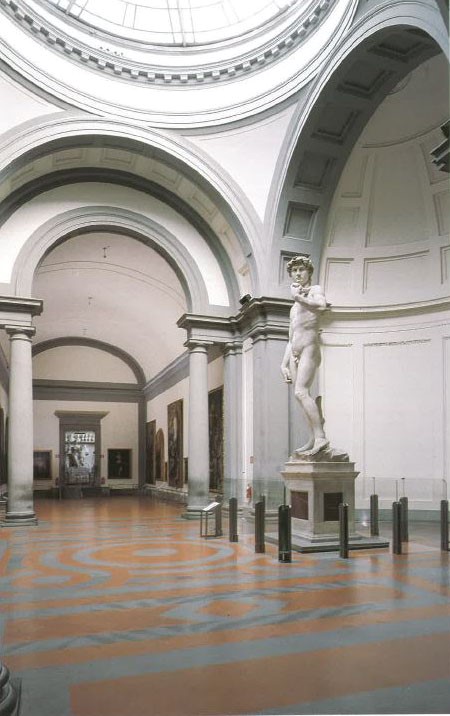
CHRONOLOGY
1847 Clemente Papi completes the mould of the marble statue of Michelangelo’s David .
1848 Using this mould Papi carved the head. A plaster copy of this is in the Accademia di Belle Arti in Florence; the whereabouts of the bronze cast of the head made at the same time are currently unknown.
1853 Clemente Papi executes a plaster copy of the complete figure, now housed in the Gipsoteca Istituto Statale d’Arte in Florence.
1856 From the same mould Papi makes a second plaster cast, now in the Victoria and Albert Museum in London.
1866 From the original mould Papi makes a bronze version of the figure.
1875 The bronze version is installed at the Piazzale Michelangelo at the top of the monument dedicated to the artist.
The plaster cast of David by Clemente Papi at Istituto Statale d’Arte of Florence, (today Liceo Artistico di Porta Romana).
The famous caster Clemente Papi (Rome 1803- Florence 1875) was a student of Francesco Carradori and Stefano Ricci (Figure 2) in the Sculpture department of the Accademia di Belle Arti in Florence. In Ricci’s private workshop he was trained in clay and plaster modelling, as well as in restoration techniques. In 1843 he was named “Real Fonditore di Statue in bronzo” (the Royal Caster of Bronze Statues) owing to his successful production of full-size bronze sculptures using the lost-wax casting technique (see for example Figure 3).
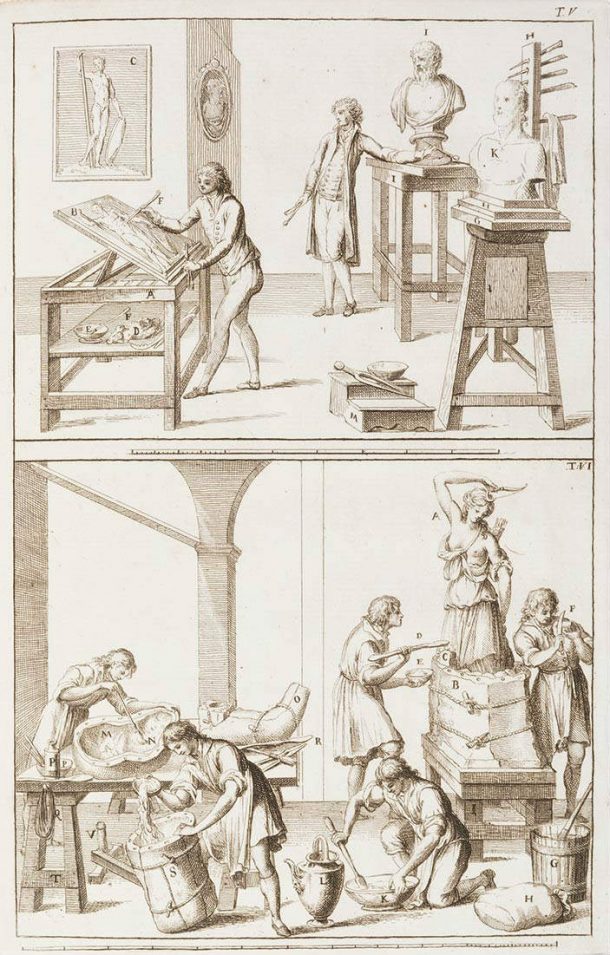
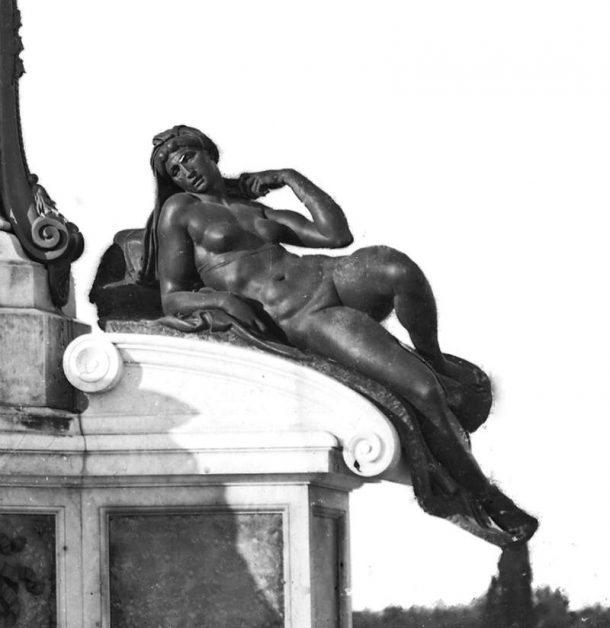
In 1838 the Grand Duke of Tuscany Leopold II provided him with the money and workshop space to establish a new foundry at the Accademia di Belle Arti in Florence. This foundry was located within the Via del Cocomero and Via della Sapienza (today the via Ricasoli and Via Battisti; this is documented in papers held at the archives of the Accademia di Belle Arti).[2]
Clemente Papi completed the plaster moulds of Michelangelo’s David in 1847, in compliance with a Grand Ducal order dated 29 August 1846. The Grand Duke Leopold II was concerned about the centuries of weathering damage to Michelangelo’s sculpture, and ordered it to be removed from its historical setting in the Florentine Piazza della Signoria. It was to be replaced with a bronze copy made by Papi. However, the moving of the David and the execution of its bronze copy had to wait for some decades. The project proved to be problematic, both because of the high costs and the public debate surrounding the decision to replace Michelangelo’s marble with a bronze copy. In particular there was great concern over the visual effect of having a bronze next to the stone facade of the Palazzo Vecchio. In addition to this, the new location for Michelangelo’s original marble was much discussed. Concerns were expressed about protecting the surface of the marble, and the importance of safeguarding both its symbolic and aesthetic value.
Nonetheless, Clement Papi set to work immediately to take a mould from the original sculpture using the dagger (a tasselli) technique. Considering the colossal size of the original David (410 cm) and, above all, its “almost rickety”[3] state, Papi needed to take immense care to avoid damaging the statue.
On 13 December 1847, after the completion of a 1500-piece mould, Papi received a fee of one-hundred golden zecchini as recognition of his mastery and for having successfully completed a work ‘of such risk and such difficulty’, particularly since “the giant David by Buonarroti” was ‘completely isolated, with just his bare legs as a support, one of them even being cracked ‘ [4] (Figure 4).
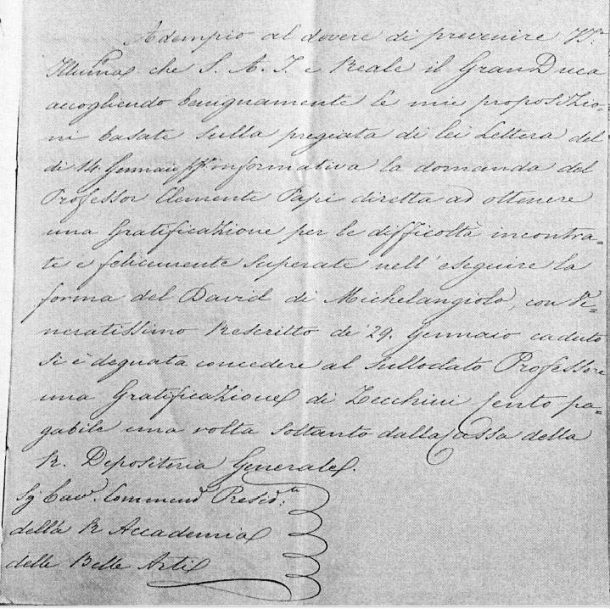
On the basis of documentary sources, I would propose that it was about six years after having made the mould that Papi created the full-figure plaster cast, now at the Gipsoteca of the Istituto Statale d’Arte of Florence. Indeed, on 3 June 1852 the Academic Council was consulted at the beginning of that year with regards to the uncertain state of David’s conservation and concerning the provisions to be taken towards its protection. This resulted in a unanimous vote on “the need to remove the David from his current position”[5], but the council did not agree on the new location. At this point, it seemed the appropriate moment for Clemente Papi to use the plaster cast to simulate the marble version in order to establish the best location. The plaster cast of David was completed by Papi in 1853, setting together four parts, the lower part of the body, until the waist, the bust, the head, the arms with the the first part filled with plaster, and first exhibited to the public on 16 July 1854 under the Loggia dei Lanzi[6] (Figure 5). In subsequent years however Papi’s plaster was moved a number of times: from the Loggia dei Lanzi to the Piazza della Signoria (where it stayed from July to October 1854) ,and from there to the so-called ‘Hall of the Colosso di Montecavallo’ in the Accademia di Belle Arti. In 1866 it was transported to the Bargello. It returned to the Accademia in 1867, where it remained until its definitive transfer to the Gipsoteca of the Istituto Statale d’Arte (Inv. 1388) in 1930.[7] (Figure 6).
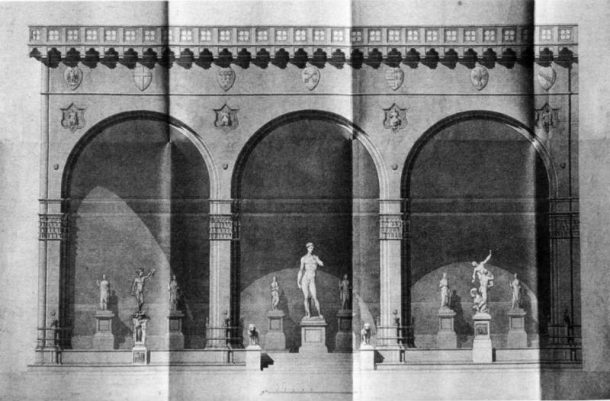
The transportation of the marble sculpture and the bronze copy
Many political changes had occurred in the meantime, including the fall of the Lorena family, the unification of Italy (1861) and the years of Florence as a capital (1865-1871). In 1869 a new commission recommended the construction of a new space, specifically designed for Michelangelo’s David. Eventually, given the precarious condition of Michelangelo’s marble, it was decided to transfer it to the collection of the Accademia di Belle Arti in 1872 (Figure 7), whilst waiting for the completion of the Tribuna, specifically designed by the architect Emilio De Fabris. This was inaugurated in 1882 (Figure 8).
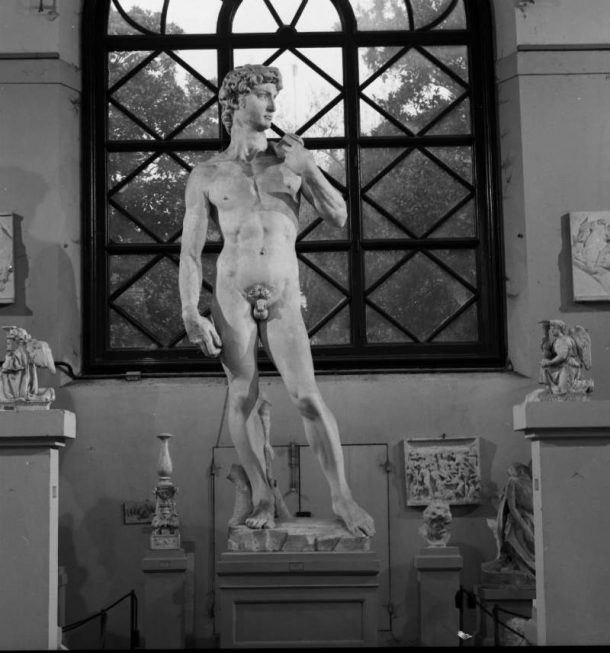
At the celebrations at the fourth centenary of the birth of Michelangelo in 1875 it was decided to exhibit the marble David within the Tribuna (even though it was still under construction), together with the plaster reproductions of other masterpieces by Michelangelo (Figure 8).

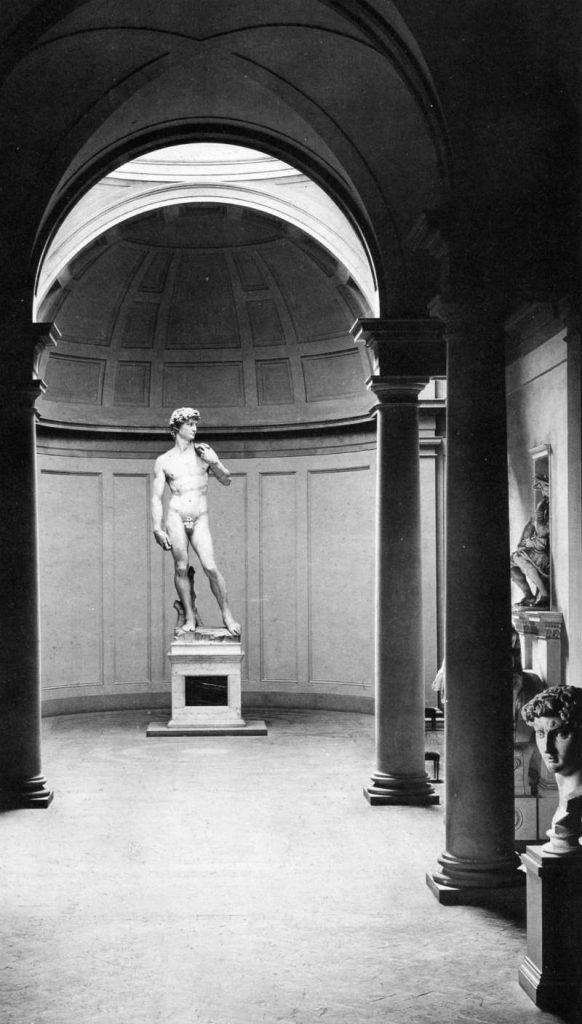
A marble copy, made by the sculptor Luigi Arrighetti, was located in Piazza della Signoria in June 1910 (Figure 9).
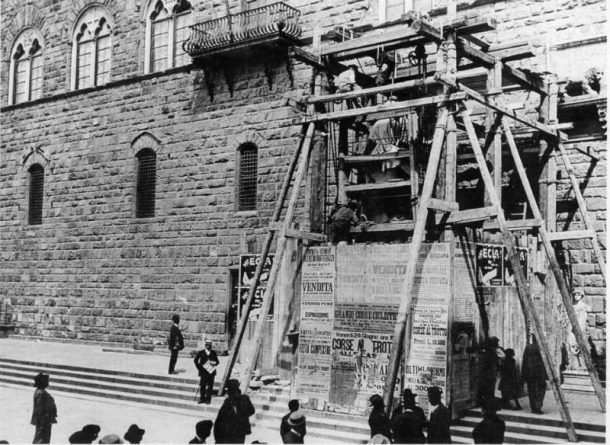
Regarding the bronze copy of the David, Leopold II ordered its production on 2 October 1858. The New National Foundry of Statues had been established a couple of years previously, near the Porta San Gallo, and housed furnaces suitable for casting a giant statue like the David[8]. However, the dispute over the possibility of placing a bronze replica in place of the original marble David in Piazza della Signoria meant that Clemente Papi did not cast the bronze David until the 16 January 1866 (Figure 10).
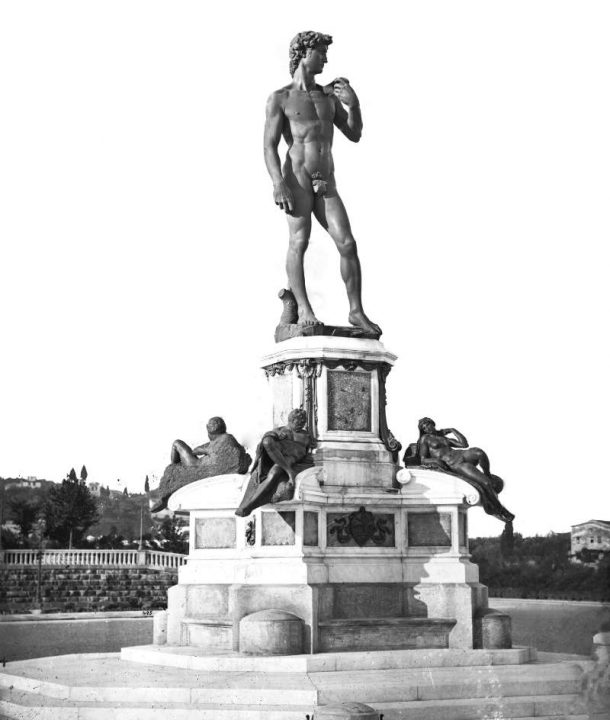
Notes on the Istituto Statale d’Arte of Florence and on the successive moulds of the David.
As noted above, the first full-length plaster cast of Michelangelo’s David by Clemente Papi has been preserved at the Istituto Statale d’Arte of Florence since 1930 (Figure 6 and Figure 11), that is based in the former Scuderia Reale of Palazzo Pitti in Porta Romana, in the Peace Park. More than 3000 plaster casts of sculptural masterpieces, dated from the 14th to the 20th century, have been collected over time in the Gipsoteca, some of them coming directly from the Accademia di Belle Arti.
A number of copies of David, made subsequently, now dispersed in various collections all over the world, were taken from this first plaster cast by Clement Papi in order to safeguard the integrity of the original sculpture.
In 1930 the Direction of the Istituto Statale d’Arte decided to make a new mould from the David. This was completed in the autumn of the same year by the Marinelli Foundry in Florence. A new mould was subsequently made at the Art Institute laboratories during the years 1955-57, under the guidance of the chief cast maker Nello Taccini.
The demand for copies of both the full figure and individual details of the David is still high today. Such copies are manufactured by many private companies (Figure 12). The most recent one was commissioned just a few weeks ago by the He University (Shenyang Qipanshan International Scenery Tourism Development Zone, China) from the Marinelli Artistic Foundry, which still owns historic casts of David[9].
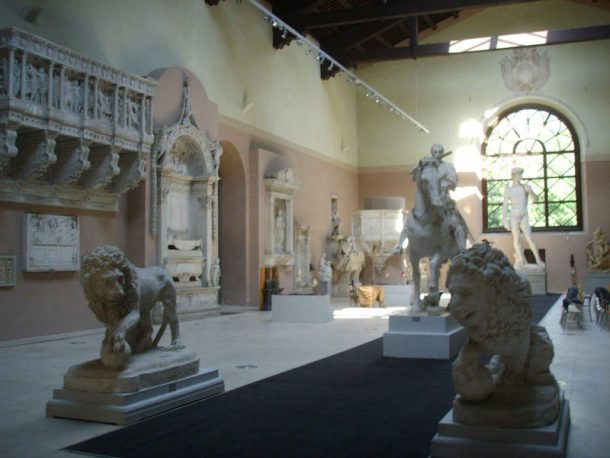
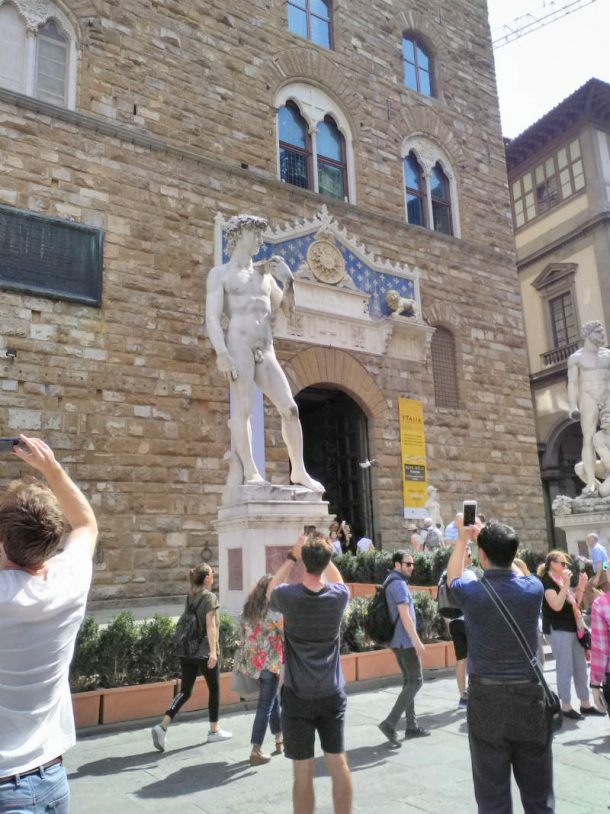
Stay tuned for Giuliana Videtta’s next post Part 2 – The Florentine copies of Michelangelo’s David by Clemente Papi – The plaster cast of the Head of David at the Accademia di Belle Arti in Florence.
GIULIANA VIDETTA
Giuliana Videtta is an art historian formerly Director of the Accademia di Belle Arti of Florence. Born in Naples, she was awarded a first class degree from Naples on 18th-century Neapolitan painting. She has taught at the Academies in Naples, Carrara, Bologna and Florence, concentrating particularly on modern and contemporary art. She lives in Florence.
Footnotes:
[1] On this subject, see the documentary material of the Archives of the Accademia di Belle Arti in Florence (AABAFi), and in particular Repertorio degli Affari dell’Accademia di Belle Arti di Firenze. 1611-1850, and Inventari di beni mobili dell’Accademia. Concerning the artistic heritage of the Accademia di Belle Arti in Florence, it is important to mention the 2012 cataloguing promoted by the Ministry of Cultural and Environmental Heritage, and carried out by Giuliana Aiello and Sandro Bellesi for the Cataloguing Office of the Superintendence and Accademia di Belle Arti. The acronym OA (for “artistic objects”), followed by a ten-digit number, is referred to this cataloguing campaign.
[2] AABAFi, f. 103 (1837), e AABAFi, f. 8-44-45 (1838). See also: Gallo Martucci, 1988, cit., p.93 and Rizzo, 2012, cit., p. 124.
[3] Archives of the Accademia di Belle Arti of Florence, Filza 1848, ins. 37A.
[4] Archives of the Accademia di Belle Arti of Florence, Filza 1848, ins. 37A.
[5] Archives of the Accademia di Belle Arti of Florence, Filza 1848, ins. 37A.
[6] AABAFi,f. 41A (1852), ins. 98, containing various documents related to the question of protection of Michelangelo’s David. See also: J. Cavallucci, Progetto di traslocamento del David del Buonarroti, in “Bollettino delle Arti del Disegno”, I, N.31, 3 agosto 1854; L’Accademia, Michelangelo, l’Ottocento, cit., 1997, “Appendice documentaria”, n. 6, pp. 69-71 e “Appendice documentaria”, n. 8, p. 71.
[7] Concerning the whereabouts of the cast, cfr. Anglani, 1997, cit., p. 29 e nota 18, p. 35; p. 30 e nota 37, p. 35. Since 2010 the Istituto Statale d’Arte was transformed to Liceo Artistico di Porta Romana.
[8] Cfr. Anna Gallo Martucci, 1989, cit., p.93.
[9] http://www.lanazione.it/firenze/cronaca/copia-david-calco-originale-1.3433452
References:
- Anna Gallo Martucci, Il Conservatorio d’Arti e Mestieri Terza Classe dell’Accademia delle Belle Arti di Firenze (1811-1850), M.C.S., Firenze, 1988.
- Annarita Caputo Calloud, “La dotazione di calchi di opere rinascimentali nell’Accademia di Belle Arti ed il centenario di Michelangelo (1784-1875)”, in Istituto Statale d’Arte. La scultura italiana dal XV al XX secolo nei calchi della Gipsoteca, catalogued edited by Luisella Bernardini, Annarita Caputo Calloud, Mila Mastrorocco, Firenze, 1989, pp. XVII-XXXIV. Scheda pp. 148-152.
- L’Accademia, Michelangelo, l’Ottocento, a series of studies edited by Franca Falletti, Sillabe, Livorno, 1997, N.1.
- Marcella Anglani, “I luoghi dei David: la Loggia dei Lanzi, il Bargello, piazzale Michelangelo, piazza della Signoria“, in: L’Accademia, Michelangelo, l’Ottocento, , pp. 28-36.
- Giuseppe Rizzo, Clemente Papi “Real Fonditore”: Vita e opere di un virtuosistico maestro del bronzo nella Firenze dell’Ottocento, in <<Mitteilungen des Kunsthistorischen Institutes in Florenz>>, 2010-2012, 54, 2, pp. 295-318.
- Giuseppe Rizzo, Il “risorgimento” dell’industria fusoria a Firenze: la regia fonderia di statue in bronzo di Clemente Papi prima e dopo l’Unità d’Italia (1837-1875), in “Bollettino della Società di Studi Fiorentini”, 20-21 (2011-2012), Alinea, Firenze, 2012, pp. 121-131.
Acknowledgements:
My thanks to Johanna Puisto, Rosarosa Manca, who also assisted me in the translation of my text and Becky Knott for editing; Anna Gallo Martucci for her support, expertise and friendship; Eugenio Cecioni, Domenico Viggiano formerly Directors of the Accademia di Belle Arti of Florence, for their kindness and for the images. I want to thank Giuliana Aiello, Sandro Bellesi, Angela Cammarota, Simonetta Luti, Daniele Mazzolai, Giuseppe Rizzo, Rocco Spina and Elisa Zadi.
Photographic credits:
Gabinetto Fotografico Gallerie degli Uffizi, Firenze; Archivi Alinari, Firenze.


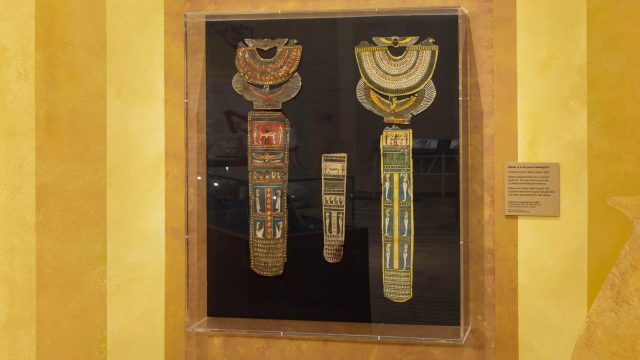
Florence hosts the famous marble of David by Michelangelo